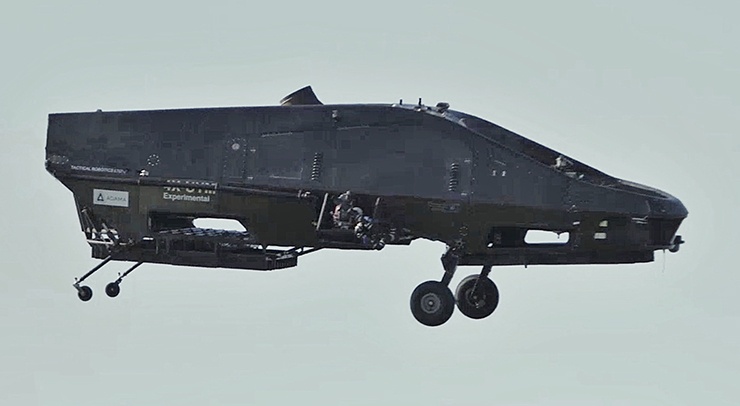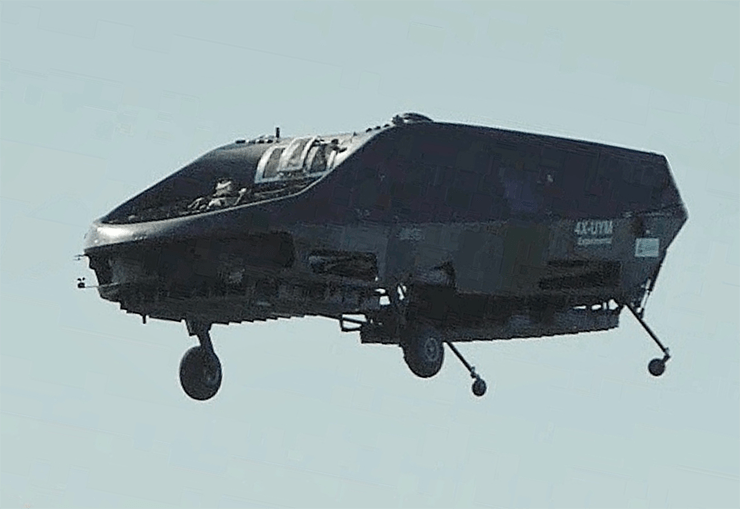
Tel Aviv. Tactical Robotics Ltd. (TRL), a wholly owned subsidiary of Israel-based Urban Aeronautics Ltd, is in talks with some armed forces that are considered potential customers for the company’s Cormorant VTOL UAV for cargo and casualty evacuation roles.
In January this year, US defence major Boeing signed an agreement with the Israeli company to explore the development of a ducted fan propulsion technology with potential uses for piloted and autonomous light aircraft.
Tactical Robotics has been developing a vertical takeoff and landing (VTOL) unmanned airborne vehicle called the Cormorant (formerly AirMule) based on its patented fancraft technologies.
In parallel TRL, the Israeli company, is in different levels of talks with the US armed forces that are looking for a better Cargo and Medical Evacuation platform than current helicopters.
Cormorant’s lift fans are powered by a single turboshaft turbine through three gearboxes and shafts.
The early prototype was powered by a Turbomeca Arriel 1D1, which was later replaced a Turbomeca Arriel 2. Originally the prototype lift fans had four-blade rotors, but the final fans have six-blade rotors with staggered-rotors for a speed variant.
One additional recent change is the elimination of the thruster fans as it has been found that with a modification to the internal fuselage shape and a few additional aerodynamic enhancements it is possible to achieve the full flight envelope without the thrusters.
Aaccording to the Israeli company, this will reduce weight and complexity, save 30 per cent of the width of the aircraft and also reduce contribute to lower signatures and higher survivability. The change was incorporated in the current prototype and a number of flights have already been performed with the change incorporated.
The Cormorant’s fuselage is constructed from carbon (fiber)-composite. Two 770 litre volume compartments are designed to accommodate litters and casualties, with room for a variety of life support equipment.
The company says that Initial interior cabin noise was measured in flight at 95 decibels without any incorporated acoustic treatment or liners. An additional 1,100 liters are available in an optional belly mounted compartment.
The fuselage forms an airfoil and generates over 50 per cent of lift at high speed aerodynamic bulge between the ducted fans keeps the airflow attached to it, hence generating lift, while diverting the airflow into the aft fan for increased lift and thrust.
The demo included taking off with a load of cargo, performing a pre-planned flight to a specified point of delivery, offloading the cargo, and loading of a specialised, medical training manikin simulating a casualty which was then returned to the point of origin.

A monitor supplied by the Israel Defense Forces (lDF) chief surgeon Trauma transmitted vital information to the crews on the ground. This is in addition to a video camera for two-way communication with the patient. With the exception of the loading of the ‘casualty’ and off—loading of cargo, the entire simulated mission was performed autonomously.
-Rafi Yoeli, president and CEO of Tactical Robotics
According to Rafi Yoeli, president and CEO of Tactical Robotics, the demonstration, a combination of cargo delivery and casualty evacuation, reflects Cormorant’s unique dual role capability as the only UAV recognised by NATO to fulfil both cargo delivery and CasEvac missions.
He added that as such the aircraft is designed to exceed the standard reliability and handling qualities required of a typical tactical UAV in order to meet the requirements to safely ferry human “cargo” back from the battlefield.
“We see the Israel Defense Forces as our first customer and we have been working with their experts to define the needed capabilities,” said Yoeli.
Yoeli added that the Cormorant is the first UAV designed in accordance with FAA passenger carrying certification standards in order to be able to transport casualties or others needing evacuation from access challenged locations.
The Cormorant is mainly aimed at medical evacuation in combat but also for emergency re-supply missions.
The current medical evacuation operational doctrine is based on helicopter evacuation as the main element of the pre-hospital military medical care system rather than ground ambulance.
There are occasions when the tactical situation prevents helicopters reaching the casualty and thus the casualty will have to be moved by ground ambulance to a safe location for a helicopter landing site.
Israeli Air Force sources say that the helicopter evacuation is mostly limited by the radius of its main rotor, it requires the preparation of a “clean” landing zone.
The ducted fans of the Cormorant allow landing in almost any point. ”The ducted fans also allow the Cormorant to evacuate from high risers. In that scenario the VTOL UAV actually touches a window or another opening in the building through which the wounded are being transferred to the aerial system.”
-The writer is an Israel-based freelance journalist. The views expressed are personal and do not necessarily carry the views of Raksha Anirveda








